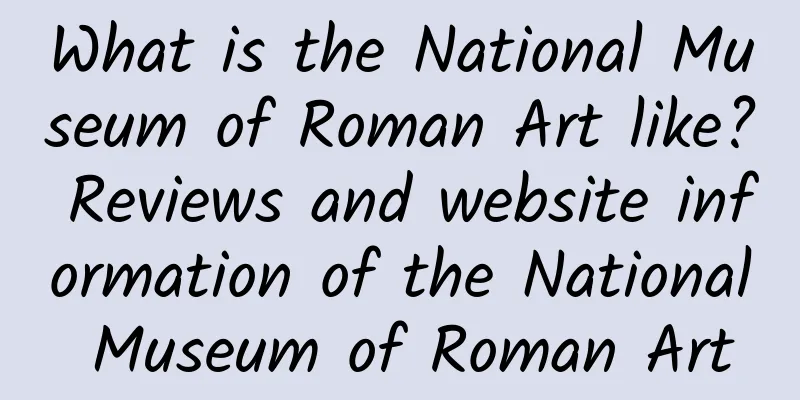What is the National Museum of Roman Art like? Reviews and website information of the National Museum of Roman Art

|
What is the website of the National Museum of Roman Art? The National Museum of Roman Art is a museum dedicated to the dissemination of Roman culture and the display of Roman artworks. It was founded on March 26, 1838; the museum headquarters was officially established on September 19, 1986, replacing the old Merida Archaeological Museum. The museum is closed every Monday. In addition, it is closed on January 1, May 1, 24, 25 and 31 every year. Website: museoarteromano.mcu.es The National Museum of Roman Art is a museum dedicated to the dissemination of Roman culture and the display of Roman artworks. It is not only a cultural landmark in the city of Merida, Spain, but also one of the most important institutions in the world for the study of Roman art and history. The history of the museum can be traced back to March 26, 1838, when it began operations as an archaeological museum. However, over time, the museum's size and influence continued to expand, and finally on September 19, 1986, the museum's headquarters was officially established, replacing the old Merida Archaeological Museum. The establishment of the National Museum of Roman Art marks Spain's emphasis on and protection of Roman cultural heritage. The museum's collection is rich and diverse, covering all types of Roman art from sculptures and murals to daily necessities. These exhibits not only showcase the glorious history of the Roman Empire, but also allow visitors to gain an in-depth understanding of the Romans' lifestyle, religious beliefs and artistic achievements. History and Development of MuseumsThe National Museum of Roman Art was formerly the Merida Archaeological Museum, which was established in 1838. Merida is a city in the Extremadura Autonomous Region of Spain. Historically, it was an important city in the Roman Empire, named "Emerita Augusta". Due to Merida's important position in the Roman period, a large number of Roman relics and artworks are preserved here, providing rich resources for the establishment of the museum. As time went by, the collection of the Merida Archaeological Museum continued to grow, and the original facilities gradually could not meet the needs. Therefore, in 1986, the Spanish government decided to build a new museum dedicated to the display and study of Roman art. The new museum was designed by the famous architect Rafael Moneo. Its architectural style combines modern and classical elements and has become one of the landmark buildings in Merida. The establishment of the museum is not only the protection of Roman cultural heritage, but also the display of Spanish cultural diversity. Through the museum's exhibitions and research activities, Spain shows the world its important position in the Roman Empire and the profound influence of Roman culture on Spanish history and culture. Museum Collections and ExhibitionsThe National Museum of Roman Art's collection covers a wide range of artworks and artifacts from the Roman Republic to the late Roman Empire. These exhibits include not only art forms such as sculptures, frescoes and mosaics, but also daily necessities, architectural components and religious objects. Through these exhibits, visitors can fully understand the Romans' lifestyle, religious beliefs and artistic achievements. The museum has a particularly rich collection of sculptures, one of the most famous of which is the Venus of Mérida. This statue is known for its elegant posture and exquisite carving skills and is considered one of the masterpieces of Roman sculpture art. In addition, the museum also has a large collection of mosaics, which, with their intricate patterns and bright colors, show the Romans' superb skills in decorative art. In addition to sculptures and mosaics, the museum's collection of murals is also very eye-catching. Most of these murals come from villas and public buildings in the Roman period, showing the Romans' achievements in painting art. Through these murals, visitors can learn about the Romans' daily life, religious beliefs, and myths and legends. The museum's exhibitions are not limited to artworks, but also include a large number of daily objects and architectural components. These exhibits demonstrate the Romans' superb skills in architecture, engineering and craftsmanship, while also reflecting the diversity and complexity of Roman society. Through these exhibits, visitors can gain an in-depth understanding of the Romans' lifestyle and social structure. Museum Architecture and DesignThe National Museum of Roman Art was designed by the famous architect Rafael Moneo. Moneo's design concept is to combine modern architecture with classical elements to create an architectural style that is both modern and historical. The museum's architectural appearance is simple and elegant, and the interior space is spacious and bright, providing visitors with a comfortable visiting environment. The architectural design of the museum fully considers the characteristics of Roman art, especially in terms of spatial layout and light design. The main exhibition hall of the museum adopts a tall vault design, giving people a sense of grandeur. The light design in the exhibition hall is also very particular, creating a solemn yet warm atmosphere through the combination of natural light and artificial lighting. In addition to the main exhibition hall, the museum also has several special exhibition halls and temporary exhibition halls to display different types of Roman artworks and artifacts. The design styles of these exhibition halls are different, but they all maintain a unified overall style with the main exhibition hall. Through this design, the museum not only provides visitors with a diverse visiting experience, but also shows the diversity and richness of Roman art. Education and research functions of museumsThe National Museum of Roman Art is not only a place to display Roman artworks, but also an important educational and research institution. The museum regularly holds various lectures, seminars and workshops, inviting domestic and foreign experts and scholars to share their research results and insights. Through these activities, the museum provides the public with an opportunity to gain a deeper understanding of Roman culture and art. In addition, the museum also has a special research department responsible for the research and protection of the cultural relics in the collection. The staff of the research department includes not only archaeologists and art historians, but also cultural relic protection experts and scientific and technological personnel. They use advanced technical means to repair and protect cultural relics to ensure that these precious cultural heritages can be preserved for a long time. The museum has also established cooperative relations with many universities and research institutions at home and abroad to jointly carry out research on Roman culture and art. Through these collaborations, the museum has not only improved its own research level, but also made important contributions to the global study of Roman culture. Museum opening hours and visiting informationThe National Museum of Roman Art is closed on Mondays, as well as January 1, May 1, December 24 and 31. The museum is open from Tuesday to Sunday from 10 am to 6 pm, and visitors can book tickets in advance on the museum's official website to avoid waiting in line. The museum's official website (museoarteromano.mcu.es) provides detailed information about the visit, including exhibition introductions, opening hours, ticket prices and transportation guides, etc. Visitors can learn about the latest exhibitions and events through the website and plan their visit in advance. For visitors who want to learn more about Roman culture and art, the museum also provides guided tours. The guides will give visitors a detailed introduction to the museum's exhibits and historical background, helping them better understand the unique charm of Roman art. The social impact and future prospects of museumsSince its establishment, the National Museum of Roman Art has been an important center for the study of Roman culture in Spain and even in the world. Through its rich collections and diverse exhibitions, the museum has not only attracted a large number of visitors, but also made important contributions to the study and dissemination of Roman culture. In the future, the museum plans to further expand its exhibitions and research projects to attract more international scholars and artists to participate. At the same time, the museum will also open more exhibits and research results to the global public through digital technology, so that more people can understand and appreciate the unique charm of Roman art. In short, the National Museum of Roman Art is not only a place to display Roman artworks, but also an important platform for spreading Roman culture and promoting international cultural exchanges. Through its rich collections, diverse exhibitions and in-depth research activities, the museum provides a unique opportunity for the global public to understand and appreciate Roman art. ConclusionThe National Museum of Roman Art is an important institution for the study of Roman culture in Spain and around the world. Through its rich collections, diverse exhibitions and in-depth research activities, the museum not only showcases the glorious history of the Roman Empire, but also provides the public with a unique opportunity to understand and appreciate Roman art. In the future, the museum will continue to be committed to the study and dissemination of Roman culture, bringing more cultural feasts to the global public. |
<<: What is The Australian? Reviews and website information
Recommend
The efficacy and effects of Sichuan Dendrobium and the contraindications of Sichuan Dendrobium
Sichuan Dendrobium is a precious variety of Chine...
What is Emperor Vegetable? The efficacy and function of Emperor Vegetable
Have you ever eaten Emperor's Vegetable? Do y...
The efficacy and function of mountain rat meat
In the eyes of many people, mountain rat meat is ...
What are the benefits of eating fresh yellow peaches?
Peach is a popular and delicious fruit in life, a...
How to eat sugar apple How to eat sugar apple
Sugar apple is a fruit of a small tree. It has a ...
How to store fresh corn? Fresh corn preservation methods and techniques
Fresh corn tastes fresh and fragrant, and is also...
How to make sausage and vegetable porridge
How much do you know about the recipe of Chinese ...
Ticket Monster Review and Website Information
What is Ticket Monster? Ticket Monster (TMon for s...
The efficacy and function of water chestnuts How to peel water chestnuts
Water chestnut is the fruit of the plant water ch...
The benefits of eating pig skin
Pig skin is the skin of the animal pig. When peop...
Ingredients and cooking methods for black garlic beef cubes
Black garlic is a very nutritious ingredient that...
Ingredients and steps for making homemade apple juice
We usually like to eat apples. If we make apple j...
The efficacy and function of orchids
Orchid is a precious flower and it also has good ...
The efficacy of red dates, white fungus and lotus seed soup
Red dates, white fungus and lotus seeds soup is a...
Planting and maintenance of rose hips
The rose is a succulent plant with thick, plump l...









